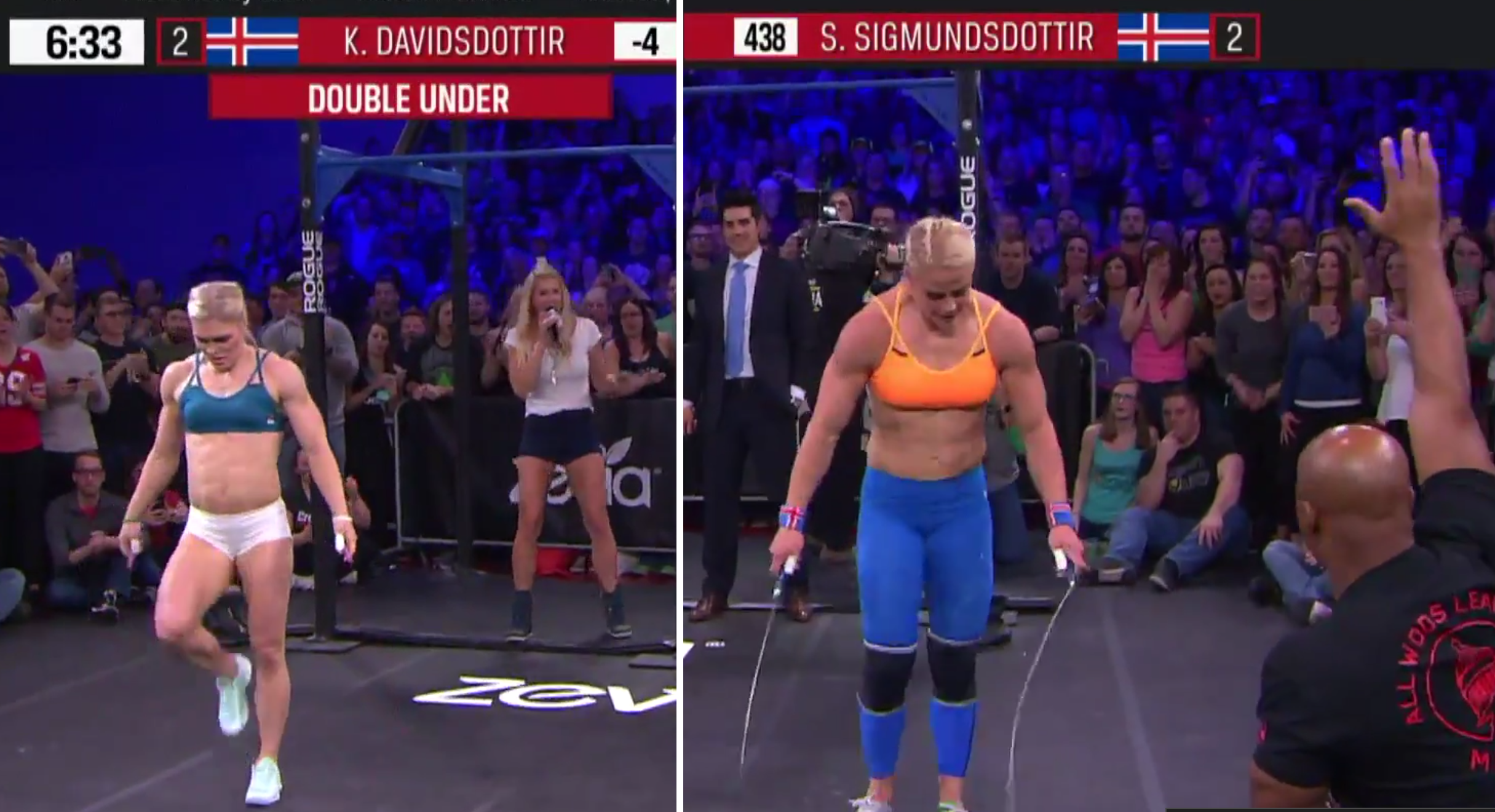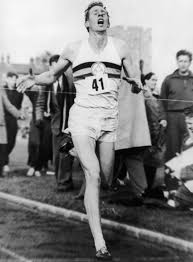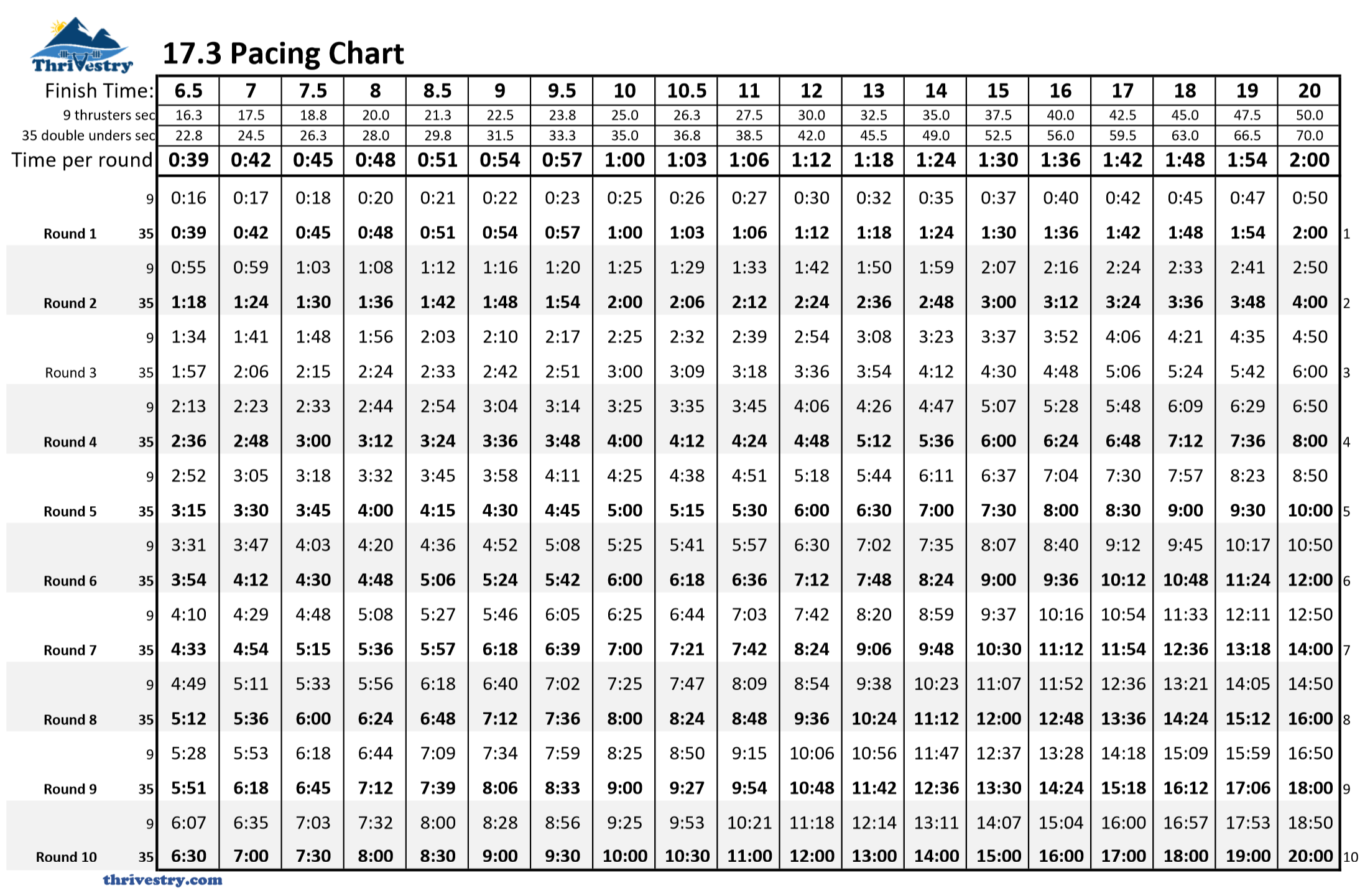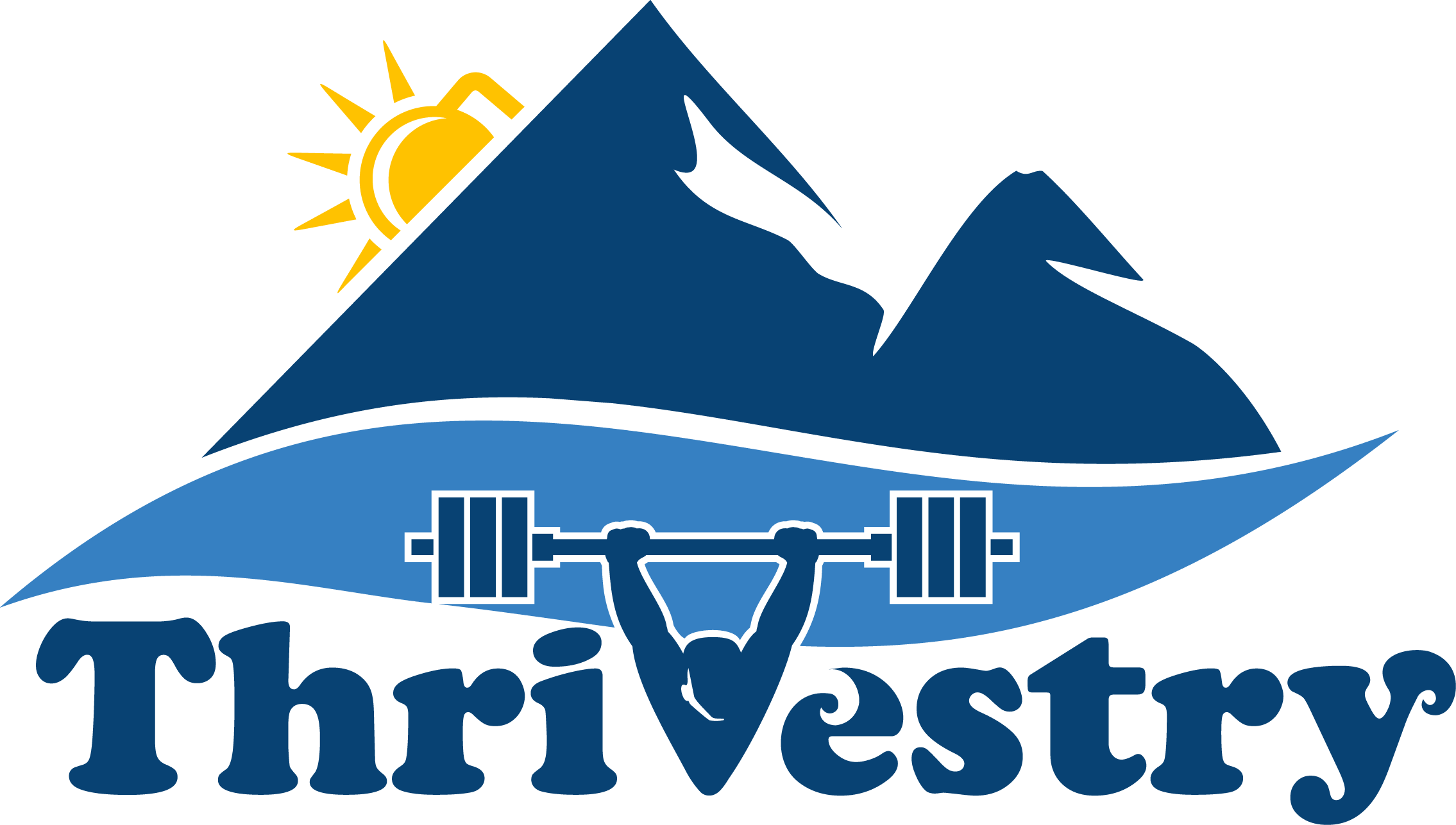CrossFit Open 17.5 Breakdown, Tips, and Cardio in a Full Body Cast
Another week were just about everyone called it! I was really hoping we’d see ring muscle ups again and maybe some shuttle runs or ‘bootlegger burpees’. I guess we’ll have to wait until next year!

And if you are still struggling with stringing double unders together, maybe after you lacerate yourself 300+ times in this workout you will actually listen to your coach and start practicing them a few times per week.
Video Overview:
Overall
This workout will be ‘different’ depending on your strengths. If you have a big motor, but struggle with double unders, you will have a different workout than someone who crushes double unders but has a terrible time squatting.
Two things that will affect just about everyone are: wind and shoulders.
Both of these movements tend to ‘gas’ people, combining them together with no other movement will make this one a real lung burner for many. They are also both shoulder movements so your shoulders will not get a break. Technique and pacing will be key to preventing your shoulders from blowing up more than they need to.
Pacing
Pacing will play a more important role than people realize on this one! I’ve heard it all: “I need to go fast in the beginning because I get tired later on…”, “I struggle with double unders when fatigued so I need to get as many done as possible early on…”, etc. These thoughts are pretty ridiculous! I can promise you that Roger Bannister didn’t run that first 4 minute mile by running a couple 45s 400 meters to start and then just said ‘let’s see what happens!’
Bannister:

I am not saying you should shoot to maintain a perfect split for the entire workout, but the pacing charts are designed to be a ‘reality check’ for people. Everyone gets that adrenaline spike at the beginning of a workout that make the weight feel light and time slow down! This will be even more prevalent on a 10 round workout where it is easy to go big on rounds 2-3-4 or 5… and then spend double or more of the time per round struggling on the later rounds because you are so tired.
Use the chart to know when to take a bit of extra rest before picking up that bar or starting the next set of double unders. Use it to speed up if realize that you are getting complacent in the middle rounds.
Most importantly, have some sort of strategy!

See the pacing chart above.
This one is pretty straight forward pacing wise, but many people still enjoy having some sort of plan to try to stick to, so I went ahead and made this one.
Select your target finish time at the top, and try to stick to the pace laid out in that column. The time is split between the thrusters and the double unders almost equally with a bit more time for the double unders for trip ups. If the workout was shorter, I probably would have had the thrusters be a smaller percent of the time, but most people will need to rest before their next set of thrusters and/or drop the bar mid set.
I recommend not getting too caught up in the middle time, just try and stick to the pace for the whole round. Get a LITTLE ahead of your pace the 2-3 rounds, but do not blow it out of the water. You will pay for it later! After 3-5 rounds, if you are feeling great, you can try and hold on until round 8 and then go for broke. Psychologically this will be hard if you are going head to head with other people. Ignore how fast others are going and ‘run your own race’. If you paced correctly, you will pass everyone else who didn’t.
If you start slipping off of your pace, drop to the next column on the right (or have your ‘pacer’ help you with that). Try to hang on to that pace until the end if you can!
“Faster” athletes (9-10 minutes or less) will have a tough time watching the clock. Write up the target times for 2, 4, 6, and 8 minutes huge on a whiteboard and try to stick to that.
Thrusters
Mobilize your shoulders so you have a good front rack for this one. You want to be able to support that bar on the shoulder with elbows slightly lower than a typical front rack for front squats (if possible). If you can rack the bar on the delts, you will not be working as hard to hold that bar through the squat portion of the lift!
Save the Shoulders
Be sure to use a lot of leg drive to get that bar overhead. If you don’t explode from the hips, you’ll end up using too much shoulder and that will punish you later on.
“Squat Curls”
Athletes who can handle the weight well should consider doing ‘squat curls’, aka ‘sneak unders’, when getting the bar to the bottom of the first thruster. Standing up with the bar and performing an eloquent squat clean will take more energy than necessary.
Down Fast
Stronger athletes should also focus on the ‘down fast’ cue. By trying to be ‘faster than gravity’ or ‘pull the bar down’, there will be less total energy spent. Trying to control the bar on the decent will wear you out faster than relaxing the muscles and receiving it at the bottom of the squat. This will speed up cycle time (and ‘intensity’ for that set), but with small sets this won’t be an issue for many people.
Athletes who shouldn’t try this are ones with back issues or ones that struggle with barbell loads. Essentially ‘dropping’ a bar from overhead down to the bottom of a squat is a recipe for a back tweak.
Break up the thrusters?
Many people may consider doing these ‘unbroken’. There is an energy penalty every time you drop the bar before the required set is over. THAT said, if you have to really ‘grind’ out those last couple reps on rounds 6, 7, or 8, you should probably consider resting sooner. Chances are, you are finishing the reps unbroken, but then you are taking a much longer time to rest before double unders.
Keep in mind that there is a strategy here. If a set of 9 is going to be challenging for you, you will rest longer than desired so that you can hit that set. If you approach the bar with the mindset that you are only going to start the set (and do 3 or 6 reps), you will rest less. If you are feeling good after that, finish the set! If you aren’t, get some reps on the board before resting. Resting at 4 or 6 reps should allow you to go to the double unders much faster.
Double Unders
Make sure you set your rope up on the ground for each set. You are NOT allowed to hang the rope on a rig or put it on a box. The rope must lay on the floor where you are doing your thrusters. That said, you should lay the rope out so that it is in a nice ‘U’ shape either facing the bar, or 90 degrees to it. The goal is to have it set up so that you can pick up the handles and the rope is already behind you ready to go (as opposed to having to untangle it, swing it behind you, etc. ). Do this for every round!
No Singles to Start
If you are fairly competent with double unders, start each set with a double under rep instead of doing a one, two, or a few singles. If you trip up once per round, and you take two singles to get started, you will be doing 40 extra singles (at least) on this workout
Do not rest when you trip up!
People who struggle with big sets of double unders will generally take too much rest when they trip up. If you mess up, because of timing or technique, get after the next set. If you tripped up because you were fatigued, take more than a few moments to get organized. That said, resting on a trip up will add a ton of time if you don’t need the rest!
Breathe
Many people who struggle getting more than 5, 10, or 15 double unders in a row are struggling because they are holding their breath or not breathing correctly during the set. Set a rhythm for yourself so that you are breathing during you double unders and you will get bigger sets (not to mention that you will be less winded after the sets)!
Resting During the Double Unders
People who are competent on the double unders (but maybe don’t have the engine), will push to finish the 35 reps, but then take an excess rest before picking up the bar. It makes more sense to rest at a set amount of double unders (breathe, get chalk, etc.), then finish the set before going right back to the thrusters. Pushing to finish the set, but then needing extra time before the barbell, will actually take MORE time than breaking the DUs into two sets, but not resting during the transition.
Double Unders in a Body Cast (for those of you who struggle with DUs)
It is important that you keep the arms close to your sides and that you don’t do too much elbow, hip, and knee flexion. Imagine you are in a body cast with only your hands and ankles exposed. Keep an upright posture and focus on just using your ankles and wrists to make the double unders happen. Rope speed is paramount. Do not try and jump higher or pull your feet up. When you start to get tired, focus on moving the rope faster to make the rep.
Getting Frustrated with Messing Up
Do not let yourself get frustrated during DUs, and do not try to ‘overthink’ your technique. Many times, people will try to make too many corrections during double unders when they are tired and that only makes it worse. Focus on being smooth and staying upright, but do not try to fix too much stuff (even if you have 5 people yelling at you to ‘help’). If the ‘wheels fall off’ while you are doing double unders, stop, take a few breaths, and get after it. Do not rush it. You can make up time on the next set of thrusters (watch Katrin and Sara during the Open announcement on the last round for an example).
Look at their body language after they had a trip up (it is pretty clear who had the better mindset):

Repeats?
This workout isn’t the worst workout to repeat, but keep in mind that you will be doing a lot of thrusters and double unders. Performing 350 double unders two or three times in 3-4 days is going to put a pretty brutal beating on your heel cords. If your goal is to perform at your absolute best during this open, then budget to do this one more than once. Make sure you are taking care of your heel cords with mobility and start with a ‘safe’ pace the first time and use it to collect data. The second time, you can adjust accordingly to try and get a better score.
2017, What Did We learn?
The difference between Champions and ‘non-champions’ is that they learn whether they win or lose. If you haven’t already, take the time to write down what you learned about yourself and where you can improve.
As a black belt and MMA fighter, I was taught the concept that “In the beginning, an ounce of effort produces a pound of results. After years of training, it takes pound of effort to produce a pound of results.” What that means in the sport of fitness is that you are best spending your time and energy focusing on turning your weaknesses into strengths than making your strengths better. A few ounces of effort on what you suck at will produce far more gains than continuing to do what you are already good at (and comfortable doing).
“Every time I’d heal up, I’d be stronger.” – Marcus Luttrell
Or as I like to say “Heal up, learn, and get better”.
Marcus is the SEAL who survided Operation Red Wing and the subject of the book/movie “Lone Survior”. Here is a video where he talks about how his mindset got him through that ordeal:
Training for 2018 has already started.
Thrive on.
-jj

0 comments
Leave a comment